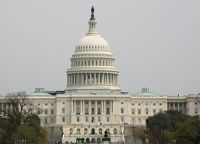
Credit rating agency Standard and Poor's decision to shift the long-term credit outlook for the United States from stable to negative is yet another reminder that the aftershocks of the global financial crisis of 2008 are yet to dissipate.
This should serve as a warning that unless the US administration and Congress can handle the fiscal consequences of the myriad stimulus measures put in place to fight the global recession, another financial crisis could be in the making. S&P's specific concern is that: "US policymakers might not reach an agreement on how to address medium- and long-term fiscal challenges."
The challenge in this case is to reduce the US debt burden from close to 100 per cent of GDP, which is likely in 2011, to more manageable levels in the medium term.
S&P's scepticism appears to stem more from its assessment of the US' current political situation in which partisan point-scoring seems to stand in the way of sensible policy making.
In short, the rift between the Republican-dominated House of Representatives, which wants to put the burden of consolidation on spending cuts alone (particularly state-funded medical insurance, Medicare), and the Democrat-controlled Senate, which wants to use a mix of higher taxes and spending reduction, could compromise any workable plan of fiscal consolidation.
This, however, is not yet an outright downgrade of US sovereign debt and it is unlikely that the US government will default on its credit obligations in the near future.
However, if concerns about fisc health intensify (US treasury credit default swap spreads have been rising steadily), the status of US treasury bonds as the "default" safe haven (and by extension the US dollar)
in times of rising risk aversion will come into question.
Europe's travails rule out any European alternative. The only viable safe haven appears to be gold and German bonds, since Germany's robust growth (and, consequently, its fiscal health) seems to be miles ahead of its moribund neighbours.
One could argue that emerging markets like India and China, despite their immediate inflation problem, should get the safe haven status.
Their underlying growth momentum (cyclical corrections notwithstanding) remains strong and their fiscal health, at least in comparison with the Western world, certainly looks to be in the pink.
On the other hand, emerging markets could face other problems. Were US treasury yields to rise on the back of fiscal anxieties, it could turn off the spigot of cheap dollars that have been flooding these markets.
Asset prices in these markets could see a sharp correction. Commodity prices that have ridden the wave of easy liquidity could also be hit.
The worst-case scenario would be one in which rising interest rates and a heavy fiscal burden could drive the US economy down and that, in turn, would pull the global economy back into the throes of a recession.
Though this seems a tad unlikely at this stage, one cannot simply wish the likelihood away.
The world expects better leadership from US politicians, but S&P is clearly doubtful if this would be forthcoming.
